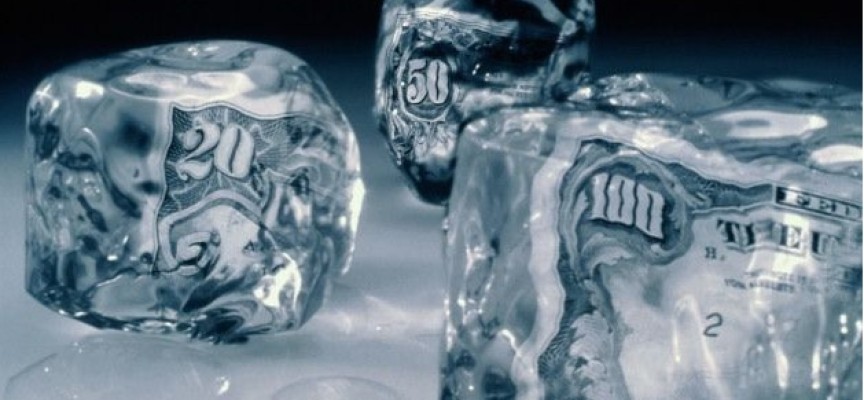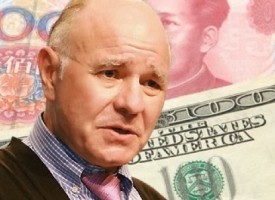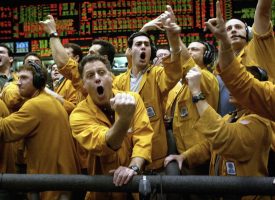There is no question we are in a global economic depression, plus why another $500 surge in the price of gold will surprise investors.
The Second Great Depression
May 13 (King World News) – John Ing: During the Great Depression, stocks lost 90 percent of their value, people lost savings and jobs. Today there are a record 33 million jobless Americans, double the 15 million jobless in the Thirties or 25 percent of the population then. And today, there are long food lines that rival those of the Great Depression. Yet looking at the stock market and its robust snapback rally, the juxtaposition between the comeback and an economy in freefall is contradictory. Of interest is that at the onset of the Great Depression, stocks actually rallied 50 percent, before losing 90 percent of their value three years later. And, looking for clues about the future from the bond market is futile given the Fed’s dominant presence. While there are similarities, they are differences.
Yet few are putting forward the consequences of the inexorable rise in debt to save the world and fewer are looking at a “never normal” future.
As the world spirals into the worst crisis since the Great Depression, the Fed and Congress have bailed out everyone and everything in conjunction with a “whatever it takes” fiscal policy to keep the economy from seizing up. Desperate times call for desperate measures. However, the grievous economic costs keep piling up. Indeed the economy has rightly been considered “essential”, and to “flatten” the curve, the cure might kill the patient. To replace their zombie economies, the world’s central banks have injected trillions of bridge financing to replace the fallout in demand. In the United States, because of the escalating cost, they are set to borrow a record $4.5 trillion, with much of the debt monetized through the printing press. The Fed has not only pledged to buy more government debt but also riskier high yield corporate debt in a move to drive rates lower and save America’s economy. However, in opening the flood gates, the extraordinary multitrillion dollar bailouts estimated at 15 percent of GDP, eclipses World War II levels. Worse, the trillions are meant to buy time, but the lack of a treatment or a vaccine means that the virus could outlast the bailouts.
Misplaced Optimism
The robust fiscal response has seen a rebound in stocks on optimistic hopes of a V-shaped recovery although much of the economy is repressed by the countrywide lockdown. Everyone wants to go back to normal. However, in the longer term are economic, financial and social consequences and worries. Even before the pandemic, debt at $25 trillion was at near record levels. Still to come is the red ink hangover from contagious corporate defaults, real estate implosions and bailouts.
On average the government borrows about 2 percent of GDP each year, however the Congressional Budget Office projects a $4 trillion budgetary deficit even before the fourth relief bailout package, on pace to eclipse the biggest shortfall in US history. Fed borrowings alone could be as high as 10 times equivalent to more than 20 percent of the size of the US economy but manageable because of record low rates. The IMF has estimated that US public sector debt will grow exponentially from 5.8 percent of national income to 15.4 percent this year and net public debt alone will rise from 85 percent to 107 percent, exceeding the level in 1986. They are not alone. France, the UK and Spain will also have debt at more than 100 percent GDP. The amounts are staggering and larger than the economic output of most countries, eclipsing soon the expenditures of the last war. Debt is growing faster than the economy, and that is just for this year, raising the spectre of a new form of contagion…
To learn about one of the most exciting silver plays in
the world click here or on the image below

The grim irony is that for almost a half century, America has incentivized debt over savings and seems stuck on a treadmill of ever increasing debt and a savings glut. America’s economy is built on debt with a tax code that makes interest for mortgages and credit cards tax deductible. Since then a generation of consumer and corporate indebtedness continued to rise making the “never normal” outlook riskier. However with a growing debt burden, there is pressure to keep rates low. In the wake of the pandemic, the Fed has made large scale government debt purchases and slashed interest rates to near zero to reduce the cost of borrowing, which encouraged business and consumers alike to strap on more debt. And after years of quantitative easing that created numerous asset bubbles, the pandemic has burst these bubbles raising insolvency risks. As a result we are left with a huge mountain of deflationary debt that might never be repaid. Ironically, the German Karlsruhe court has thwarted the European Central Bank’s (ECB) flagship bond-buying purchases, arguing presciently that monetary financing of governments by the central bank is illegal under the EU treaty.
Oil for Nothing
Amid the struggle against the pandemic, it is the world that is in peril, hiding in plain sight. The market is reeling from a double punch delivered first by the financial crisis and now oil. Emblematic is the crash in the price of oil which saw oil fall to negative territory for the first time.
Saudi Arabia and Russia were locked in a “game of chicken” and the failure to curtail production caused the Saudis to unleash a price war, which backfired as the Saudis flooded the market with oil. At a time when there was already an oil glut from sharply lower demand due to the lockdown, oil futures collapsed and with storage tanks overflowing, the oil price fell below $0 a barrel when sellers actually paid buyers $37 a barrel to take oil off their hands.
The Trump administration initially celebrated the price collapse, but backtracked when their high cost shale players facing giant losses screamed for bailouts. The dysfunctional relationship between the physical and paper market widened. Typically, when future contracts come up for expiration, investors rolled over the contracts into a future period or settled their position. The disaster was triggered by a lack of buyers and the holders of a Chinese ETF, “Yuan You Bao (Crude Oil Treasure) was forced to take $1.2 billon of losses. Many EFTs use leveraged derivatives to heighten performance and when the stock market collapsed last month, investors headed for the same exit and as a result, ETFs were forced to dump their positions to pay for redemptions. ETFs are the proverbial “roach hotels”, easy to get into but harder to get out of. In the last quarter, the value of hedge fund investments dropped by $333 billion, as markets plunged in an unprecedented surge in volatility and uncertainty.
Central Banks Are Part of The Problem
The impact of the plague on global demand and supply chains means that trade volumes will shrink, likely to the lowest levels in decades. The pandemic greatly increases the urgency and inflationary risks. As the bailouts grow and amid the cries for more state support and intervention from the airlines, steel makers, real estate or retail businesses, we are reminded that every new stimulus plan ironically enables the de facto nationalization of the American economy. Corporate America tacitly has lined up as cows in an abattoir, at respectable social distances of course, pleading for public funding for their businesses. Boeing for example with $30 billion of debt seeks a whopping $60 billion of loans to survive the virus. US airlines will get $25 billion and small businesses were allocated $350 billion in emergency assistance, which is all gone because some of that largesse went to publicly traded giants and the Los Angeles Lakers basketball team. Worse may be in store. Next up? Central banks buying oil or as in Japan, equities as buyers of last resort? Marx would have been proud that the takeover of Corporate America by the states had become so easy, with socialism reigning in the epicentre of capitalism.
A major worry of course, is that the pandemic’s deflationary effects makes debt loads even harder to manage as interest and principal remains fixed. Governments this time must manage a debt overhang with debt to GDP in excess of 100 percent of national income, a level where many countries get into financial trouble. The problem is much of the past firepower had limited success and instead created a Wall Street bubble that bypassed Main Street America, increasing the wealth disparity fueling the populism of today. Central banks’ balance sheets led by the Fed at almost $7 trillion are already at $18 trillion and set to explode again as they prop up their economies and financial markets. Central banks are supposed to be stewards of our money, not creators. The net result is that the Fed has become part of the problem, and not the solution. Again they are repeating the same mistakes of the past with America’s learning curve unfortunately flatter than their infection rates…
ALERT:
Legendary investors are buying share of a company very few people know about. To find out which company CLICK HERE OR ON THE IMAGE BELOW.
 Sponsored
Sponsored
While, there is no doubt that the central bank’s trillion dollar measures will stabilize most of the economy and bridge the demand to allow the economy to recover once the lockdown expires, over the intermediate term, the bailouts won’t revive growth. Asian markets were the first to be hit by Covid-19, so their factories were the first to pick up, but demand still lags. But things are not as clear-cut. Once the engine for global growth for the past two decades, China’s growth shrank for the first time in 40 years. China is still in semi-formal lockdown. With broken supply chains to be resolved and store shelves to be restocked, America’s growing rivalry with China will create bottlenecks, impacting exports, demand and inflation. Second, while lockdowns are lasting longer in some countries, there are already food and commodity shortages, which governments cannot easily access despite turning on the monetary spigots. Agriculture and food prices have risen at a time when household incomes too are squeezed. Thirdly, in the shadow of an election year, no one is prepared to talk about austerity so the monetary and fiscal taps will remain turned on.
It Has Happened Before
Understandably there are similarities to the Great Depression. While deflation is a major worry, we should look instead to the hedonism of the Roaring Twenties that was similarly marked by a credit driven euphoria, setting the stage for a stock market boom that ended in the crash of 1929 and the Great Depression. And eerily similar to today, there was an orgy of conspicuous consumption financed by a credit bubble that saw Americans buy cars, homes and art, or three quarters of major household items on credit. Of course this credit boom deflated in 1929. Today after the longest economic run in American history, the Fed has again aimed a fire hose of lending to avoid a serious downturn, even backstopping Wall Street’s plumbing system, the repo market, the linchpin of the US financial system. The Fed also introduced a quantitative easing to infinity, underwriting everyone and everything, flooding the economy with “base” money to buy time and stabilize the economy. And, like before the stock market, real estate and automotive bubbles again have gone bust. In the scramble for answers, the main question is whether the extraordinary measures will lead to excessive inflation, or a deflationary period of austerity.
Day of Reckoning
All told, the market is hoping that the pandemic is a temporary shock and when that ends, aggregate demand will return to normal and the pent-up demand could swamp supply. However, the “anything goes” credit markets are in a tailspin and a surge in defaults and bankruptcies is likely as the unprecedented decade of corporate binge borrowings clash with the government’s need to fund a gargantuan debt load. The problem with the Fed becoming an agent of the Treasury Department is that there will be a reckoning once we emerge from the pandemic and that reckoning could take a generation or more to recover from. Noteworthy was that it took 23 years after the Great Depression for the economy to return to pre-Great Crash levels. And, no one has yet to pay down the national debt, only adding to it in both bad times and good times.
So how are the Americans to pay for their bailouts and much enlarged budget deficits?
The amounts are staggering. After all, it took the costs of World War II to dig America out of its hole from the Great Depression. To be sure, we don’t need another war. Debt on debt is not good. America will find that deficit spending financed by borrowings is unsustainable. Holders of dollars today are increasingly frustrated as they watch the Fed dilute or debase their holdings by trillions. While the economy is in lockdown, interest rates compounds and the additional debt must be sold but to whom? For now, the Fed is financing the government but there will be a time when America’s debt cannot be sold except at much higher interest rates. In the aftershocks of the bailouts, unlike the collapse during the Great Depression, money supply growth has actually exploded this year.
In 1981, global debt was $14 trillion. In the run-up to Covid-19, global debt was pegged at $300 trillion or an increase of more than 20 times but the cost of that debt was kept artificially low as rates were slashed from 20 percent to zero, making it more manageable. Today the US must borrow trillions on a horrific scale, to pay for the stimulus and bailouts. America will thus have a $2 trillion deficit and $25 trillion of debt. To be sure, other countries have worse debt to GDP ratios than the United States, but America’s good fortune is that the dollar is the world’s reserve currency and the linchpin of the global financial system. It is the world’s money, and foreigners want to hold its debt, for now. Of concern, is what is to happen when interest rates increase, because the value of financial liabilities is far greater than the underlying financial assets?
China Versus The US
We thus believe the Covid-19 deficits have advanced the day of reckoning. Popular opinion is that since America controls its own currency and able to borrow to infinity, they can always print more money to solve their financing problem. To date, foreigners have financed up to a third of America’s debt but given an “America First” stance and the current climate of “beggar thy neighbor” policies, America’s creditors, specifically, China is not so anxious to finance America given the new Cold War and when the level of trust between the superpowers are at an all time low…
IMPORTANT:
To learn which junior explorer is looking to drill multiple major tier one discoveries CLICK HERE OR ON THE IMAGE BELOW
 Sponsored
Sponsored
China is one of the largest holders of America’s debt and has reduced its vast holdings of US treasuries, just at a time when America needs to ramp up borrowings to pay for Covid-19 related costs. There is also a growing risk that China may repatriate funds which would push down bond prices causing yields to spike upward. Then there is that other check writer, Saudi Arabia who is locked in a price war and also is looking for financing to close its deficit gap. Without foreign help, the Fed has bought almost $2 trillion of Treasury debt, using its balance sheet and off balance sheet manoeuvres to fill the financing gap. We should be reminded that both World War I and II, and the Vietnam War were financed by excessive levels of borrowings, which led to double digit inflation that debased the dollar, triggering a recession
Inflating Its Way Out of Debt
History shows that inflation may be the only way out for debt laden governments to pursue since it erodes the real value of debt. For the past decade, inflation has been notably absent despite the rounds and rounds of quantitative easing, which should have ignited inflation. However for much of the decade, money supply was restrained. Although there was little Main Street inflation, there was inflation in the stock market, real estate and of course in the central banks’ balance sheet. After the 2008 financial crash, the Fed saw its balance sheet explode from $800 billion to $4.6 trillion, from rounds and rounds of quantitative easing (QE 1-4). This time, with a balance sheet already at almost $7 trillion, the government and the Fed’s emergency moves and the proposed deficits from the rescue packages will push the Fed’s balance sheet over $10 trillion or 60 percent of US annual economic output, a record for any country. While there are parallels with the deflation of the Thirties, we are reminded of earlier instances when nations’ defaulted on debts through inflation. As history is being made, it is also being repeated. We believe the conditions are ripe for a hyperinflation bomb in the making.
It has happened before. In 1920s Germany was forced to pay for World War I reparations. Germany consequently incurred huge deficits and the country printed money to pay for its bills over a period of three years. Deficits were even monetized and then on July 31st 1914, the German central bank, the Reichsbank devalued and suspended the convertibility of German money into gold. A week later, a new law authorized the Reichsbank to discount German debt, printing money to pay for its bills, initiating the disastrous monetary hyperinflation. A loaf of bread cost $14. Grand pianos were used as currency. The Monetary Law of August 1924 ended the horrible hyperinflation, revaluing 1,000,000,000,000 Marks for one new Reichsmark or one Rentenmark. Few, saw this coming.
Today, unlike the demand for toilet paper, hand sanitizers, masks and now yeast, there is no shortage of money. That is the problem. Money has no value. In the past decade, money has fled to the stock market, classic cars and condos but what is the value today? What will money’s value be tomorrow after the trillions are added to the money supply? The history of government borrowings shows that when the output of goods and services grows more slowly than increases in money, inflation is inevitable. To be sure, there is more red ink in the offing and we believe today’s debt regime resembles too many tumultuous periods of the past.
But It Is All About Trust
We recall that it was just in the Eighties when Former Fed Chair Paul Volcker, brought back the dollar from the brink of hyperinflation by jacking up interest rates to double digit levels, after the great inflation of the 1970s. He once said, “It is a government’s responsibility to maintain the value of the currency they issue. And when they fail to do that, it is something that undermines an essential trust in government”. It is this trustworthiness or lack thereof in America’s sovereign debt that is of concern today and our belief that the downturn by necessity will result in a new geopolitical and monetary order.
Specifically the only thing that underpins fiat currencies today is the belief that governments are credible and trustworthy. Exacerbating this trust or the lack thereof is public trust in government which lately has run low due to the lack of truths, transparency, leadership and preparedness in fighting the virus. The pandemic has already cost too much but trust has fallen victim to the virus. The true extent of Covid-19 infections or even death rates is unknown as each country politicizes its numbers. The UK was recently said to understate its death rate by 40 percent, or Wuhan death numbers doubled overnight after China revised its numbers.
Who or what can citizens trust? Such is the contradictions that with America’s fiscal house in disorder and having too many liabilities against too few assets, the escalating pandemic together with the experience of depleted stocks of PPE or lack of ventilators, the public has become much more skeptical of government’s ability to protect them. We believe in the pandemic’s aftermath, the United States with huge debts to pay down, will find that trust in the greenback is not forever, particularly if the current wave of extraordinary policy measures unleashes a wild bout of inflation. The US dollar could be Covid-19’s biggest victim.
On and Off the Gold Standard
It’s war. At least in Donald Trump’s world, describing himself as a “wartime president” in the fight against the coronavirus pandemic. True, public spending is set to reach levels last seen after World War II. However until the Forties, wars were paid in gold because bankers did not want to take the currency of the loser. In fact, the gold standard worked well for centuries. However at the end of World War I, Germany had to pay their reparations with gold, but the financing strain was so huge that they suspended the gold standard and instead financed their obligations with borrowings, thus paving the way for the Weimar Republic hyperinflation.
Ironically, back then, Britain’s pound was the world’s reserve currency, but they too had very heavy war bills to pay and were also forced off the gold standard in 1919 because of a run on the pound. The slump of the Thirties followed. And, after the second war in 1944, the victorious allies came up with a system, which replaced the pound with the US dollar under the Bretton Woods Agreement, making the dollar, the world’s reserve currency…
IMPORTANT:
One of the great gold opportunities and you can take a look at this remarkable company and listen to the just-released fantastic interview with the man who runs it by CLICKING HERE OR BELOW
In early 1933, the US government also devalued, abandoning the gold standard and confiscated everyone’s gold at $20.67 per ounce. The government then devalued the dollar, pegging the dollar at $35 per ounce, resulting in a competitive “beggar thy neighbour” policy with its trading partners, which paved the way for Hoover’s Smoot Hawley Tariffs. The devaluation caused money supply to explode allowing Franklin D. Roosevelt to pay for his New Deal, which kickstarted the economy. In fact, the gold held in Fort Knox today is from the gold seized by the American government.
Under the 1944 Bretton Woods Agreement, the world was under a dollar/gold standard and the United States held roughly 60 percent of the world’s gold supply. But soon there was more dollars than gold so in 1971, President Nixon severed the gold link which turned money into paper. The financial strain of the Vietnam War and the cost of Lyndon Johnson’s “Great Society” caused a run on the dollar. Nixon closed the gold window breaking up the Bretton Woods Agreement, making the dollar the world’s dominant fiat inconvertible currency. Other countries followed and fixed their currencies against the mighty dollar, not gold. After 1971, the US economy fell out of bed and gold went from $35 an ounce to over $350 an ounce.
Of course, over the subsequent decades, the US enjoyed a virtually unlimited line of credit in its own currency. Without the discipline of gold, the United States racked up horrific amounts of debt to finance its large and growing deficits, consumption and wars. And while the markets have stumbled from crisis to crisis as the Fed monetized ever greater quantities of government liabilities, the United States’ financial hegemony has allowed it to impose sanctions, as such that foreigners have resented this abuse of the dollar’s power. Today the world’s faith in the dollar is being tested. History showed that in Germany, Britain and now in the United States that at some point, a day of reckoning occurs. With the United States, becoming the largest debtor in history and conducting a full-scale bailout of everything, that day is soon.
The Golden Constant
Today, the world financial system is awash with dollars and yet another wave of dollars is being produced which will no doubt cushion the global economy, but at a huge cost of a more indebted financial system.
Economic history tells us that when central banks print a lot of money, inflation rises. It is a monetary phenomenon. We consequently believe that hyperinflation is a greater risk today than the 1930’s style of depression.
We believe that entering the “never normal”, the dollar’s days are numbered due to this massive creation of dollars from the bailouts and America’s earlier fiscal profligacy. The world is drowning in an avalanche of cheap dollars as America must pay for its debts and deficits. And that is the problem. Policymakers, oblivious to the past are acting to cushion their economies to avoid a deflationary depression but America’s position is weaker than investors think. Unlike collateralized debt obligations, Boeing shares or Central Park condos that have lost value recently, gold has never been completely worthless. It was FANG stocks last year, this year the “never normal” will be gold, a trusted store of value for centuries.
So the rise in gold is not a surprise. Gold is a currency and if investors believe that currencies are failing, gold is an effective hedge and store of value. In fact gold has posted record highs in euros and yen, trading at an eight year high in dollars, increasing by a third in the past two years. Gold is the canary in the coal mine. In this century we have seen a series of upheavals and at long last because of America’s profligacy, Covid-19 and rising debt load, the dollar’s dominance is being questioned. Without confidence in the dollar, the world has no valid reserve currency. Gold is an alternative to the dollar. As for the pandemic, gold is a perfect hedge. It is risky either way. If the virus persists or the inevitable “deadly second wave” occurs, gold will rise on the effects. If a vaccine is found, gold will rise on the hangover of the cure.
Skeptics believe gold’s performance is a “flash in the pan”. They are wrong. Gold’s rise shows that investors are nervous. While gold is a barometer of investor anxiety, over the longer term, gold is a hedge in both deflationary and inflationary times. While inflation was mostly absent for much of the decade (except for real estate, bonds, classic cars and the stock market), we think that after the deflationary Covid-19 forces abate, the consequences of the largest fiscal stimulus in history will prove to be inflationary, maybe even hyperinflationary. In November, the Americans will elect another inflationary president. Gold will be a good thing to have in this “never normal “climate. We continue to call for a near term target of $2,200 an ounce but expect higher prices before the end of this cycle.
Recommendations
Much is made of the almost decade-long period when gold miners lagged bullion. The main reason is that until the last couple quarters, the miners were not generating free cash flow due to higher costs, stretched balance sheets and falling mine grades. For a time they were poor investments. Except for declining grades, the other factors no longer weigh on the group and to no surprise, gold shares have outperformed the markets. Recent first quarter results show most with free cash flow and widening margins. As investors rediscover their appetite for gold, we believe gold stocks’ bull run has only begun.
This Is How Bad Things Are
***Also Released: This Is How Bad Things Really Are In The Economy CLICK HERE.
***To listen to James Turk discuss the global collapse, what investors should be doing right now and where the major markets are headed click here or on the image below.
© 2020 by King World News®. All Rights Reserved. This material may not be published, broadcast, rewritten, or redistributed. However, linking directly to the articles is permitted and encouraged.









